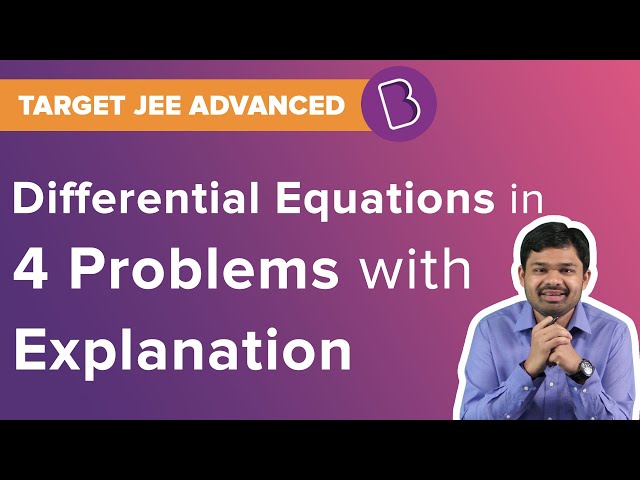JEE is an examination conducted every year for admission into various institutions in the country. This page includes the answers for all the questions asked in JEE Main 2020 Mathematics Solutions (Shift 2, 8th January). JEE Main has a fixed structure and is not subjected to change every year. Therefore, referring and practising these questions will help in scoring well in the examination.
January 8 Shift 2 - Maths
1. Let ? and ? be two events such that the probability that exactly one of them occurs is 2/5 and the probability that ? or ? occurs is 1/2, then the probability of both of them occur together is
- a. 0.10
- b. 0.20
- c. 0.01
- d. 0.02
Solution:
-
P(? or ?) = ?(? ∪ ?) = 1/2
P(exactly one of ? or ?)= 2/5
⇒ P(?) − ?(? ∩ ?) + ?(?) − ?(? ∩ ?) = 2/5
⇒ P(? ∪ ?) − ?(? ∩ ?) = 2/5
⇒ P(? ∩ ?) = 1/10
Answer: (?)
2. Let ? be the set of all real roots of the equation, 3x (3x − 1) + 2 = |3x − 1| + |3x − 2|. Then S:
- a. is a singleton.
- b. is an empty set.
- c. contains at least four elements
- d. contains exactly two elements.
Solution:
-
3? (3? − 1) + 2 = |3 ? − 1| + |3? − 2|
Let 3? = ?
t(? − 1) + 2 = |? − 1| + |? − 2|
⇒ ? 2 − ? + 2 = |? − 1| + |? − 2|
We plot ? 2 − ? + 2 and |? − 1| + |? − 2|
As 3 ? is always positive, therefore only positive values of ? will be the solution.

Therefore, we have only one solution.
Answer: (?)
3. The mean and variance of 20 observations are found to be 10 and 4, respectively. On rechecking, it was found that an observation 9 was incorrect and the correct observation was 11. Then the correct variance is:
- a. 4.01
- b. 3.99
- c. 3.98
- d. 4.02
Solution:
-
Mean = 10 ⇒ ∑ ??/20 = 10 ⇒ ∑ ?? = 200
Variance = 4 ⇒ ∑ ?? 2/20 − 100 = 4 ⇒ ∑ ?? 2 = 2080
New mean = (200−9+11) / 20 = 202/20 = 10.1
New variance = (2080−81+121)/ 20 − (10.1) 2
= 106 − 102.01 = 3.99
Answer: (?)
4. Let ?⃗ = ?̂− 2?̂+ ?̂, ?⃗ = ?̂− ?̂+ ?̂ be two vectors. If ?⃗ is a vector such that ?⃗× ?⃗= ?⃗× ?⃗and ?⃗. ?⃗= 0 then ?⃗. ?⃗ is equal to:
- a. 1/2
- b. – 3/2
- c. – 1/2
- d. −1
Solution:
-
?⃗ = ?̂ − 2?̂ + ?̂
?⃗ = ?̂ − ?̂ + ?̂
?⃗× ?⃗= ?⃗× ?⃗
⇒ ?⃗ × ( ?⃗ × ?⃗ ) = ?⃗× (?⃗× ?⃗)
⇒ (?⃗. ?⃗ ) ?⃗ − (⃗?⃗. ?⃗)?⃗= (?⃗. ?⃗)?⃗ − (?⃗. ?⃗)?⃗
⇒ − (⃗?⃗. ?⃗)?⃗= (?⃗. ?⃗)⃗?⃗ − (?⃗. ?⃗)?⃗
⇒ −4?⃗= 6(?̂− ?̂+ ?̂) − 4(?̂− 2?̂+ ?̂)
⇒ ?⃗ = − 1/2 (?̂ + ?̂ + ?̂)
∴ ?⃗. ?⃗= − ½
Answer: (?)
5. Let ?: (1,3) → ? be a function defined by ?(?) = ?[?] /(? 2+1) , where [?] denotes the greatest integer ≤ ?. Then the range of ? is:
- a. ( 2/5 , 3/5 ] ∪ ( 3/4 , 4/5 )
- b. ( 2/5 , 4/5 ]
- c. ( 3/5 , 4/5 )
- d. ( 2/5 , 1/2 ) ∪ ( 3/5 , 4/5 ]
Solution:
-
f(?) = ?[?]/(?2+1)

Answer: (?)
6. If ? and ? be the coefficients of ? 4 and ? 2 respectively in the expansion of
- a. ? + ? = −30
- b. ? − ? = −132
- c. ? + ? = 60
- d. ? − ? = 60
Solution:
-
\((x+\sqrt{x^{2}-1})^{6}+(x-\sqrt{x^{2}-1})^{6}\)
= 2[6?0? 6 + 6?2? 4 (?2 − 1) + 6?4? 2(? 2 − 1) 2 + 6?6 (?2 − 1)3]
= 2[32? 6 − 48? 4 + 18? 2 − 1]
⇒ ? = −96, ? = 36
⇒ ? − ? = −132
Answer: (?)
7. If a hyperbola passes through the point (10, 16) and it has vertices at (±6, 0), then the equation of the normal at ? is:
- a. 3? + 4? = 94
- b. ? + 2? = 42
- c. 2? + 5? = 100
- d. ? + 3? = 58
Solution:
-
Vertex of hyperbola is (±?, 0) ≡ (±6, 0) ⇒ ? = 6
Equation of hyperbola is (? 2/?2) – (? 2 / ?2) = 1
⇒ (? 2/36) – (? 2/? 2) = 1
As ? (10,16) lies on the parabola.
(100/36) – (256/ ?2) = 1
⇒ 64/36 = 256/?2
⇒ ?2 = 144
Equation of hyperbola becomes (? 2/36) – (? 2/144) = 1
Equation of normal is (? 2?/?1) + (? 2? /?1) = ? 2 + ? 2
⇒ (36?/10) + (144?/16) = 180
⇒ (?/50) + (? /20) = 1
⇒ 2? + 5? = 100
Answer: (?)
8.
- a. 0
- b. 1/10
- c. – 1/10
- d. − 1/5
Solution:
-
\(\lim_{x\rightarrow 0}\frac{\int_{0}^{x}tsin (10t)dt}{x}\)
Applying L’Hospital’s Rule:
=
\(\lim_{x\rightarrow 0}\frac{xsin10x}{1}=0\)Answer: (a)
9. If a line, ? = ?? + ? is a tangent to the circle, (? − 3) 2 + ? 2 = 1 and it is perpendicular to a line ?1, where ?1 is the tangent to the circle, ? 2 + ? 2 = 1 at the point ( 1 /√2 , 1/√2 ); then:
- a. ? 2 + 7? + 6 = 0
- b. ? 2 − 6? + 7 = 0
- c. ? 2 − 7? + 6 = 0
- d. ? 2 + 6? + 7 = 0
Solution:
-
For circle, ? 2 + ? 2 = 1
2? + 2?? ′ = 0 ⇒ ? ′ = − ?/y
Slope of tangent to ? 2 + ? 2 = 1 at ( 1/√2 , 1/√2 ) = −1
⇒Slope of tangent to (? − 3) 2 + ? 2 = 1 is 1 ⇒ ? = 1
Tangent to (? − 3) 2 + ? 2 = 1 is ? = ? + ?
Perpendicular distance of tangent ? = ? + ? from centre (3, 0) is equal to radius = 1
| (3 + ?)/√2 | = 1
⇒ ? + 3 = ±√2
⇒ ?2 + 6? + 9 = 2
⇒ ?2 + 6? + 7 = 0
Answer: (?)
10. Let ? = (−1+?√3)/2 . If
- a. ? 2 + 101? + 100 = 0
- b. ? 2 + 102? + 101 = 0
- c. ? 2 − 102? + 101 = 0
- d. ? 2 − 101? + 100 = 0
Solution:
-
? = (−1+?√3)/2 = ?
\(a= (1+\alpha )\sum_{k=0}^{100}a^{2k}\)⇒ ? = (1 + ?)[1 + ? 2 + ? 4 + ⋯ . +? 200]
⇒ ? = (1 + ?) [ (1 − (? 2 ) 101)/(1 − ? 2) ]
⇒ ? = [ (1 − (? 2 ) 101 )/(1 – ?) ] = [ (1 – ?)/( 1 – ?) ] = 1
\(b= \sum_{k=0}^{100}a^{3k}\)= 1 + ? 3 + ? 6 + ⋯ . . + ? 300⇒ ? = 1 + ? 3 + ? 6+. . . . +?300
⇒ ? = 101
Required equation is ? 2 −102? + 101 = 0
Answer: (?)
11. The mirror image of the point (1, 2, 3) in a plane is (− 7/3, − 4/3 , − 1/ 3 ). Which of the following points lies on this plane?
- a. (1, −1, 1)
- b. (−1, −1, 1)
- c. (1, 1, 1)
- d. (−1, −1, −1)
Solution:
-
Image of point P(1, 2, 3) w.r.t. a plane ?? + ?? + ?? + ? = 0 is ? (− 7/3 , − 4/3 , − 1/3 )
Direction ratios of ??: − 10/3, − 10/3 , − 10/3 = 1, 1, 1
Direction ratios of normal to plane is 1, 1, 1
Mid-point of ?? lies on the plane
∴ The mid-point of ?? = (− 2/3 , 1/3 , 4/3 )
∴ Equation of plane is ? + (2/3) + ? – (1/3) + ? – (4/3) = 0
⇒ ? + ? + ? = 1
(1, −1, 1) satisfies the equation of the plane.
Answer: (?)
12. The length of the perpendicular from the origin, on the normal to the curve, ? 2 + 2?? − 3? 2 = 0 at the point (2, 2) is:
- a. 2
- b. 2√2
- c. 4√2
- d. √2
Solution:
-
Given curve: ? 2 + 2?? − 3? 2 = 0
⇒ ? 2 + 3?? − ?? − 3? 2 = 0
⇒ (? + 3?)(? − ?) = 0
Equating we get, ? + 3? = 0 or ? − ? = 0
(2, 2) lies on ? − ? = 0
∴ Equation of normal will be ? + ? = ?
It passes through (2, 2)
∴ ? = 4
? ∶ ? + ? = 4
Distance of ? from the origin = | −4/√2 | = 2√2
Answer: (b)
13. Which of the following statements is a tautology?
- a. ~(? ∧ ~?) → (? ∨ ?)
- b. (~? ∨ ~?) → (? ∧ ?)
- c. ? ∨ (~?) → (? ∧ ?)
- d. ~(? ∨ ~?) → (? ∨ ?)
Solution:
-
~(? ∨ ~?) → (? ∨ ?)
= (? ∨ ~?) ∨ (? ∨ ?)
= (? ∨ ?) ∨ (? ∨ ~?)
= ? ∨ ?
= ?
Answer: (?)
14. If
- a. 1/6 < I 2 < 1/2
- b. 1/8 < I 2 < 1/4
- c. 1/9 < I 2 < 1/8
- d. 1/16 < I 2 < 1/9
Solution:
-
Let
\(f(x) = \frac{1}{\sqrt{2x^{3}-9x^{2}+12x+4}}\)? ′ (?) = (−(6? 2 − 18? + 12))/ 2(2? 3 − 9? 2 + 12? + 4) 3/2 = (−3(? − 1)(? − 2))/ (2? 3 − 9? 2 + 12? + 4) 3/2 ⇒ ???? = ?(1) and ???? = ?(2)
\(f(1) = \frac{1}{\sqrt{2-9+12+4}}\)= 1/√9 = 1/3
\(f(2) = \frac{1}{\sqrt{16-36+24+4}}\)= 1/√81/3 < I < 1/√8
⇒ 1/9 < I 2 < 1/8
Answer: (?)
15. If
- a. 6I − ?
- b. ? − 6I
- c. 4I − ?
- d. ? − 4I
Solution:
-
If
\(A = \begin{bmatrix} 2 & 2\\ 9 & 4 \end{bmatrix}\)\(A^{-1} = -\frac{1}{10}\begin{bmatrix} 4 & -2\\ -9 & 2 \end{bmatrix}\)\(10A^{-1} = \begin{bmatrix} -4 & 2\\ 9 & -2 \end{bmatrix}\)⇒ 10? −1 = ? − 6I
Answer: (?)
16. The area (in sq. units) of the region {(?, ?) ∈ ? : ? 2 ≤ ? ≤ 3 − 2?}, is:
- a. 31/3
- b. 32/3
- c. 29/3
- d. 34/3
Solution:
-
We have ? 2 ≤ ? ≤ −2? + 3

For point of intersection of two curves
? 2 + 2? − 3 = 0
⇒ ? = −3, 1
⇒
\(Area = \int_{-3}^{1}((-2x +3)-x^{2})dx\)= 32/3 sq. units
Answer: (?)
17. Let ? be the set of all functions ?:[0,1] → ?, which are continuous on [0, 1] and differentiable on (0, 1). Then for every ? in ?, there exists a ? ∈ (0,1), depending on ?, such that:
- a. (f(1)−?(?))/ (1−?) = ?′(?)
- b. |f(?) − ?(1)| < |?′(?)|
- c. |f(?) + ?(1)| < (1 + c)|? ′ (?)|
- d. |f(?) − ?(1)| < (1 − ?)|?′(?)|
Solution:
-
? is set of all functions.
If we consider a constant function, then option 2, 3 and 4 are incorrect.
For option 1:
(f(1) − ?(?))/ (1 – ?) = ?′(?)
This may not be true for f(?) = ? 2
None of the options are correct.
Answer: (Bonus)
18. The differential equation of the family of curves, ? 2 = 4b(? + ?), ? ∈ ?, is:
- a. ??′′ = ?′
- b. x(?′) 2 = ? + 2??′
- c. x(? ′ ) 2 = ? − 2??′
- d. x(? ′ ) 2 = 2?? ′ − ?
Solution:
-
? 2 = 4(? + ?) … (1)
Differentiating both the sides w.r.t. ?, we get
⇒ 2? = 4?? ′
⇒ ? = ?/2?′
Putting the value of ? in (1), we get
⇒ ? 2 = (2?/?′) (? + (? /2?′))
⇒ ? 2 = (2?? /?′ )+ (? 2/ ?′2)
⇒ x(? ′) 2 = 2?? ′ + x
Answer: (b)
19. The system of linear equations
?? + 2? + 2? = 5
2?? + 3? + 5? = 8
4? + ?? + 6? = 10 has:
- a. no solution when ? = 2
- b. infinitely many solutions when ? = 2
- c. no solution when ? = 8
- d. a unique solution when ? = −8
Solution:
-
\(D = \begin{bmatrix} \lambda & 2 &2 \\ 2\lambda & 3 & 5\\ 4& \lambda & 6 \end{bmatrix}\)
= 18? − 5? 2 − 24? + 40 + 4? 2 − 24
⟹ ? = −? 2 − 6? + 16
Now, ? = 0
⇒ ? 2 + 6? − 16 = 0 ⇒ ? = −8 or 2
For ? = 2
\(D_{1} = \begin{bmatrix} 5 & 2 &2 \\ 8& 3 & 5\\ 10& 2 & 6 \end{bmatrix}\)= 40 + 4 − 28 ≠ 0
∴ Equations have no solution for ? = 2.
Answer: (a)
20. If the 10?ℎ term of an A.P. is 1/20 and its 20?ℎ term is 1/10 , then the sum of its first 200 terms is:
- a. \(50\tfrac{1}{4}\)
- b. 100
- c. 50
- d. \(100\tfrac{1}{2}\)
Solution:
-
?10 = 1/20
?20 = 1/10
?20 − ?10 = 10?
⇒ (1/20) = 10?
? = 1/200
∴ ? = 1/200
?200 = (200/2) [2 (1/200) + 199 ( 1/200)]
=
\(100\tfrac{1}{2}\)Answer: (?)
21. Let a line ? = ?? (? > 0) intersect the parabola, ? 2 = ? at a point ?, other than the origin. Let the tangent to it at ? meet the ? −axis at the point ?. If area (Δ???) = 4 sq. units, then ? is equal to __________ .
Solution:
Let the co-ordinates of ? be (? 2, ?)
Equation of tangent at (? 2, ?) is ? − ? = (1/2?) (? − ? 2 )
Therefore, co-ordinates of ? will be (−? 2, 0)
Area of Δ??? = 4
\(= \frac{1}{2}\begin{bmatrix} 0 & 0 &1 \\ t^{2}& t & 1\\ -t^{2}& 0 & 1 \end{bmatrix}=\pm 4\)⇒ ? 3 = ±8
⇒ ? = ±2
⇒ ? = 2 as ? > 0
? = 1/? = ½
Answer: (0.5)
22. Let f(?) be a polynomial of degree 3 such that ?(−1) = 10, ?(1) = −6, ?(?) has a critical point at ? = −1 and ?′(?) has a critical point at ? = 1. Then the local minima at ? =______
Solution:
-
Let the polynomial be
f(?) = ??3 + ?? 2 + ?? + ?
⇒ ? ′ (?) = 3?? 2 + 2?? + ?
⇒ ? ′′(?) = 6?? + 2?
? ′′(1) = 0 ⇒ 6? + 2? = 0 ⇒ ? = −3?
? ′ (−1) = 0 ⇒ 3? − 2? + ? = 0
⇒ ? = − 9a
f(−1) = 10 ⇒ −? + ? − ? + ? = 10
⇒ −? − 3? + 9? + ? = 10
? = −5? + 10
f(1) = -6
⇒ ? + ? + ? + ? = -6
⇒ ? − 3? − 9? − 5? + 10 = -6
⇒ ? = 1
∴ ? ′ (?) = (3? 2 – 6? – 9
= 3?2 − 2? − 3
For ? ′ (?) = 0 ⇒ ? 2 − 2? − 3 = 0 ⇒ ? = 3, −1
Minima exists at ? = 3
Answer: (3)
23.
Solution:
- \(\frac{\sqrt{2}sin\alpha }{\sqrt{1+cos2\alpha }} = \frac{1}{7}\)\(\frac{\sqrt{2}sin\alpha }{\sqrt{2}cos\alpha }= \frac{1}{{7}}\)
⇒ tan ? = 1/7
\(\sqrt{\frac{1-cos2\beta }{2} }= \frac{1}{\sqrt{10}}\)⇒ (√2 sin?) /√2 = 1 √10
⇒ sin? = 1 √10
⇒ tan ? = 1/3
tan 2? = (2 tan ?)/ (1 − tan2 ?) = (2/3)/(1 – 1/9) = 3/4
tan(? + 2?) = (tan ? + tan 2?)/( 1 − tan ? tan 2?)
= (1/7 + ¾)/(1 – (1/7) × (3/4)) = 1
Answer: (1)
24. The number of 4 letter words (with or without meaning) that can be made from the eleven letters of the word “EXAMINATION” is _________ .
Solution:
-
Word “EXAMINATION” consists of 2?, 2?, 2?, ?, ?, ?, ?,
Case I: All different letters are selected
Number of words formed = 8? 4 × 4! = 1680
Case II: 2 letters are same and 2 are different Number of words formed = 3?1 × 7? 2 × (4!/ 2!) = 756
Case III: 2 pair of letters are same
Number of words formed = 3? 2 × 4!/(2!×2!) = 18
Total number of words formed = 1680 + 756 + 18 = 2454
Answer: (2454)
25. The sum,
Solution:
-
\(\sum_{n=1}^{7}\frac{n(n+1)(2n+1))}{4}\)\(\frac{1}{4}\sum_{n=1}^{7}(2n^{3}+3n^{2}+n)\)\(\frac{1}{4}\left [2\sum_{n=1}^{7}n^{3}+3\sum_{n=1}^{7}n^{2}+\sum_{n=1}^{7}n \right ]\)\(\frac{1}{4}\left [2\times (\frac{7\times 8}{2})^{2}+3 \times (\frac{7\times 8\times 15}{2})+(\frac{7\times 8}{2}) \right ]\)
= 504
Answer: (504)



















